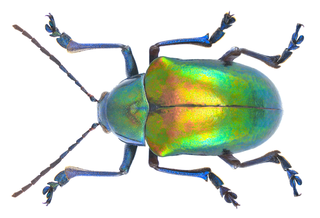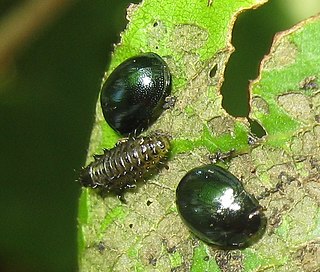
The flea beetle is a small, jumping beetle of the leaf beetle family (Chrysomelidae), that makes up the tribe Alticini which is part of the subfamily Galerucinae. Historically the flea beetles were classified as their own subfamily.

Bromius obscurus, the western grape rootworm, is a species of beetle in the leaf beetle family. It is the only member of the genus Bromius. The distribution of the species is holarctic; it can be found in North America, wide parts of Europe, and Asia. The species is a known pest of grape vines in Europe and western North America.

Eumolpus is a genus of leaf beetles in the subfamily Eumolpinae. It includes 40 species, most of which have a large size and include some of the largest members of the subfamily. They are distributed throughout the Neotropical realm, though one species has been recorded as far north as Arizona, and the genus is not found in the Caribbean.
Macrocoma lefevrei is a species of leaf beetle of Saudi Arabia, Oman, Yemen, Iran and Egypt. It was first described by Joseph Sugar Baly in 1878.
Macrocoma millingeni is a species of leaf beetle of the Arabian Peninsula and Mesopotamia, described by Maurice Pic in 1898.
Macrocoma haiensis is a species of leaf beetle of Morocco, described by Louis Kocher in 1967.

Chrysomelini is a tribe of leaf beetles in the family Chrysomelidae. There are over 150 described genera in Chrysomelini, variously arranged into subtribes, though the exact number and constituency of these subtribes is a source of ongoing debate.

Eumolpini is a tribe of leaf beetles in the subfamily Eumolpinae. It is the largest tribe in the subfamily, with approximately 170 genera found worldwide. Members of the tribe almost always have a longitudinal median groove on the pygidium, which possibly helps to keep the elytra locked at rest. They also generally have a subglabrous body, as well as appendiculate pretarsal claws.

Chrysochus is a genus of leaf beetles in the subfamily Eumolpinae. It is known from North America, Europe and Asia.
Aoria is a genus of leaf beetles in the subfamily Eumolpinae. Members of the genus are distributed in East and Southeast Asia. Food plants are known for only a few species, all of which were recorded from Vitaceae.

Euryopini is a tribe of leaf beetles in the subfamily Eumolpinae.

Bromiini is a tribe of leaf beetles in the subfamily Eumolpinae. The tribe contains approximately 120 genera, which are found worldwide. They are generally thought to be an artificial group, often with a subcylindrical prothorax without lateral ridges and covered with setae or scales.
Macrocoma bolivari is a species of leaf beetle from Morocco. It was first described by Spanish entomologist Manuel Martínez de la Escalera in 1914, as a species of Pseudocolaspis.

Macrocoma setosa is a species of leaf beetle found in Algeria and Morocco It was first described by Hippolyte Lucas in 1846, as a species of Pseudocolaspis.
Macrocoma cylindrica is a species of leaf beetle found in southern Spain. It was first described by Heinrich Carl Küster in 1846, as a species of Pachnephorus. A subspecies or variety of the species later described from Morocco, M. c. vaucheri, is now considered a synonym of Macrocoma setosa.

Macrocoma rubripes is a species of leaf beetle from Europe, Asia and possibly North Africa. It was first described by Ludwig Wilhelm Schaufuss in 1862, as a species of Pseudocolaspis.

Coptocephala is a genus of beetles belonging to the family Chrysomelidae. The genus was first described by Louis Alexandre Auguste Chevrolat in 1836.

Trichochrysea hirta is a species of leaf beetle found in Indonesia and Peninsular Malaysia in Southeast Asia. It has a metallic blue or green body covered with white hair, after which the species gets its scientific name: the species epithet, hirta, is derived from the Latin hirtus, meaning "hairy".

Walterianella is a genus of flea beetles in the family Chrysomelidae. There are more than 40 described species in Walterianella. They are found in Central and South America.
















